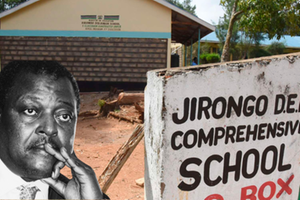Why Ruto changed tune on WHO hub

President William Ruto, Health CS Susan Nakhumicha and Prime Cabinet Secretary Musalia Mudavadi during the commissioning of the Kenyatta University Teaching, Referral and Research Hospital Cyberknife Centre on April 24, 2023.
Geopolitics may have played a role in President William Ruto’s decision to grant the World Health Organization (WHO) 30 acres of land belonging to Kenyatta University.
This decision is in contrast to his stance last year when he opposed the move, which was fronted by his predecessor, Uhuru Kenyatta.
It now emerges that Kenya would have stood to lose more than gain if the Emergency Regional Hub for Eastern and Southern Africa was established elsewhere.
According to the WHO, Kenya is the most strategic location for the hub, as it provides easy access to 25 countries in the region.
Furthermore, Dr Ruto has pledged to grant the WHO an additional 50 acres of land in Mombasa for its use.
He endorsed the deal while speaking at the Kenyatta University Teaching and Referral Hospital, stating that the project would position Kenya as a regional hub.
He described the land given to WHO as unutilised and noted that despite the allocation, the university would still have sufficient land for expansion.
Last year, Kenyatta University had opposed giving away the land, arguing it needed it for expansion.
In his speech, the President announced that he had instructed Investments, Trade and Industry Cabinet Secretary Moses Kuria to allocate 50 acres of land in Mombasa to the WHO.
He said the process would be completed within a month, but did not provide any specific details regarding the location of the land.
“The ball will be squarely in your court thereafter,” Dr Ruto told the WHO representatives during the meeting at the Kenyatta University Teaching, Referral and Research Hospital on Monday when he launched the Cyberknife Centre.
However, a similar plan was opposed last year amid allegations of shady deals and land grabbing. At the time, the vice-chancellor, Prof Paul Wainaina, and the university council stood in the way but were all forced out of office. The government then hastened the transaction before it was stopped by the courts.
Capitalised
Coming just a month before the general election, Dr Ruto who was then deputy president, and the Kenya Kwanza brigade capitalised on the conflict and rallied behind Prof Wainaina.
After the Kenya Kwanza party came into power, Prof Wainaina was reinstated as the vice-chancellor of Kenyatta University. In addition, he was appointed to serve on the Presidential Working Party on Education Reforms.
“It’s not been easy; it’s been a long way but it happened because you wanted it to happen,” said WHO representative, Dr Abdourahmane Diallo, during the signing of the memorandum of understanding at Afya House that will see the organisation establish the Emergency Regional Hub for Eastern and Southern Africa.
Health Cabinet Secretary Susan Nakhumicha, who signed the MoU on behalf of the government, described the establishment of the hub as a “long overdue, historical and momentous occasion”.
The Emergency Regional Hub for Eastern and Southern Africa is expected to coordinate high-quality responses to health emergencies in Kenya and the region, as well as serve as a modern storage facility for essential medical equipment and consumables.
The hub is also expected to offer timely support to countries experiencing emergencies.
“The hub will serve as a centre of excellence specialised in capacity building in health crisis and emergency management. Through this partnership with WHO, we will have access to the organisation’s global network of experts, knowledge, and resources. We will also be able to leverage the latest innovations and technologies to improve our response times and our ability to provide essential healthcare services during emergencies,” Ms Nakhumicha said.
Dr Ruto said the hub would provide employment opportunities, capacity building and technology transfer.
He, however, ruled out giving part of the university land to individuals claiming to be squatters from the Kamae neighbourhood.
Mr Kenyatta had allocated 190 acres for the settlement of the squatters. The former president had also set aside 10 acres for the Africa Centre for Disease Control and 180 acres for Kenyatta University Teaching, Referral and Research Hospital.





